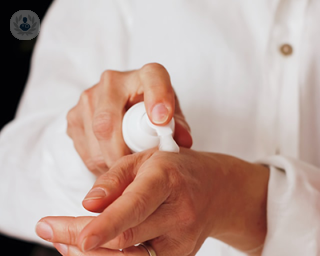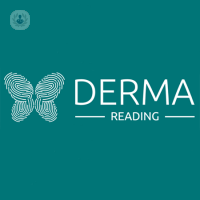Seborrheic dermatitis
Dr Emilia Duarte Williamson - Dermatology
Created on: 10-19-2015
Updated on: 04-02-2023
Edited by: Jay Staniland
What is seborrheic dermatitis?
Seborrheic dermatitis is a skin condition that primarily affects your scalp. It causes scaly patches, stubborn dandruff and red skin. The condition can also affect other oily areas of the body, such as sides of the nose, the face, ears, eyebrows, eyelids and chest.
Seborrheic dermatitis is also referred to as seborrheic eczema and seborrheic psoriasis. The condition is known as cradle cap in infants and causes scaly, crusty, patches on the scalp.

What is the prognosis of seborrheic dermatitis?
Seborrheic dermatitis can go away without treatment, or you may need repeated treatments before the symptoms go away. Seborrheic dermatitis can also recur.
What risk factors make a person more likely to develop seborrheic dermatitis?
There are various factors that can increase your risk of developing seborrheic dermatitis, including:
- Psychiatric and neurologic conditions, such as depression and Parkinson's disease
- A weakened immune system
- Recovery from stressful medical conditions
- Some medications
What are the symptoms of seborrheic dermatitis?
Seborrheic dermatitis signs and symptoms may include:
- Dandruff on your scalp, hair, beard, eyebrows or moustache
- Patches of greasy skin covered with yellow scales or a flaky white crust on the scalp, sides of the nose, face, eyebrows, ears, eyelids, chest, armpits, groin area or under the breasts
- Red skin
- Itching
- Your back and upper chest, between your shoulder blades, may have round, pink or red patches with mild scaling
- Redness, inflammation or appearance of scales in areas such as the cheeks nose, armpits, ears, shoulders and groin
How does seborrheic dermatitis differ from dandruff?
Seborrheic dermatitis is characterised by yellow, greasy scales which can extend from the scalp onto areas of the skin, such as the ears, nose, eyelids or eyebrows. Dandruff, however, typically presents as small white flakes only on the scalp and in the hair.
How is seborrheic dermatitis diagnosed?
A dermatologist will be able to determine whether you have seborrheic dermatitis by examining your skin. They may scrape off skin cells for examination (biopsy) to rule out conditions with symptoms similar to seborrheic dermatitis, including:
- Psoriasis
- Atopic dermatitis (eczema)
- Tinea versicolor
- Rosacea
What are the causes of seborrheic dermatitis?
It's not fully known what causes some people to develop seborrheic dermatitis though it's thought to be associated with a yeast called malassezia. Everyone has malassezia on their skin, however, those who have seborrheic dermatitis are more sensitive to it or seem to have more of it. This leads to an inflammatory reaction.
In the majority of people, seborrheic dermatitis isn't associated with any underlying conditions. The condition isn't caused by having very dry skin or being unclean and it isn't related to your diet. You can't catch it and pass it on to another person.

What can trigger or worsen seborrheic dermatitis?
Symptoms can get worse when you're stressed, tired or generally unwell. You may notice that your symptoms are better in warmer weather and worse when it's cold.
What are the treatment options for seborrheic dermatitis?
Creams, shampoos, and lotions are the main treatments for seborrheic dermatitis. Treatment specifically includes:
- Shampoos, creams or ointments that control inflammation
- Antifungal creams or shampoos alternated with another medication
- Antifungal medication you take as a pill
Treatment options will depend on your symptoms so it's best to speak with a dermatologist who will be able to advise further.
Can seborrheic dermatitis be cured?
Although there is no definitive cure for seborrheic dermatitis, treatment can be very effective in managing symptoms. Antifungal medication and antifungal gels, creams and shampoos in combination with products which control inflammation can greatly improve symptoms of redness, dandruff and crusting.
What lifestyle advice can help to manage seborrheic dermatitis?
Over the counter dandruff shampoos can help relieve symptoms of seborrheic dermatitis in the first instance. Different brands of anti-dandruff shampoos contain different active ingredients so it is a good idea to try various products. Shampooing the hair and scalp daily can help to improve symptoms. Once the scalp’s condition has improved, you can continue to wash the hair only as needed.
When applying the shampoo, it’s important to allow time for the active ingredients to work and so you should read and follow the instructions for use carefully. If one type of shampoo is initially effective but becomes less so over time, alternating between two or three products may be useful. If the dermatitis has spread to the skin, applying anti-dandruff shampoos to the affected areas before rinsing the area well with water can also improve the skin’s condition.
The following measures may also help to relieve symptoms:
- Soften the scalp by applying an oil (such as olive or mineral oil) for around one hour. This will allow you to remove some of the scales. Then brush and thoroughly wash the hair.
- Wash the skin very regularly with medicated products and follow with moisturiser. Do not use harsh or scented products or those which contain alcohol.
- Avoid using personal grooming and styling products such as hair gels or sprays while treating the condition.
- Wear smooth, cotton clothing that allows air to circulate on the affected areas of the skin.
- If the dermatitis is present in the beard or moustache, shampoo the facial hair regularly.
Some patients also benefit from taking fish oil supplements or from using tea tree oil or aloe vera in the affected areas.
What type of doctor treats seborrheic dermatitis?
Specialist dermatologists treat seborrheic dermatitis.







